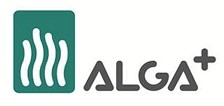Seaweed production, ALGAPLUS, Portugal

Introduction
Macroalgae
Marine macroalgae are macroscopic algae, typically divided in 3 groups: red (Rhodophyta), brown (Phaeophyta) and green (Chlorophyta). As indicated by its name, the main characteristic that distinguish them from microalgae it’s their size, varying from a few millimeters up to over 70m (in the case of the “giant kelps” – Nereocystis and Macrocystis). Like all algae, macroalgae are photosynthetic organisms, capable to transform solar energy, carbon dioxide (CO2) and other nutrients (such as nitrogen and phosphorus) into biomass, functioning as natural bio-remediation agents.
According to the Food and Agriculture Organization of the United Nations (FAO), the annual production of marine macroalgae was, in 2010, over 16 million tons (>96% from aquaculture), valued at more than 7 billion USD. To obtain the full value of the seaweed industry we still need to consider the added value of the macroalgae after processing and the extraction of several macroalgae-derived products. Macroalgae and/or macroalgae-derived products are nowadays indispensable for the food industry (human and animal), cosmetics and pharmaceutics, being constantly studied for the development of new biotechnology products and processes. This wide range of applications is due to the enormous diversity of compounds found in the macroalgae tissue, depending namely on the species and the environmental conditions.
Besides the highly appreciated nutritional value (good source of proteins, essential amino-acids, minerals and some vitamins associated with low calories), macroalgae have many other attractive properties such as potential anti-oxidative, anti-viral, anti-cancer and anti-bacteriologic effects. In animal aquaculture, macroalgae are being used for several species (either directly as food or as ingredient in feed), but the majority of their potential benefits are yet to be studied and exploited. Another avenue for macroalgae exploitation is their use as raw material for the production of energy (bioethanol, biodiesel or methane).
The company ALGAPLUS

ALGAPLUS, was founded in 2011 and is based in Aveiro, Portugal. The enterprise was born from two researchers following the idea to apply their knowledge and experience into a business with impact in the aquaculture, environment and biotechnology sectors.
The mission of the company is the production and trade of seaweed and seaweed-derived products in an ecological and social sustainable approach through continuous innovation and strict parameters of quality and traceability and to promote the implementation of Integrated Multi-Trophic Aquaculture systems (IMTA).
The major strategie of the company is to associate the cultivation of seaweed with animal aquaculture, taking advantage of the excess of nutrients existing in these systems and contributing to the environmental and economic sustainability of the aquaculture industry. Further to adapt the cultivation conditions in order to produce customized biomass for the seaweed processing industries and to keep a strong R&D component in order to optimize processes and develop new products.

Photos & text extracted from: ALGAPLUS, www.algaplus.pt
The site
This section contains intormation about the site and the conditions that affect the facility and its operation.
Facility and equipment
Provides a more detailed description of the facility and the equipment used.
Planning and operation
This section describes the general production plan and the operation of the facility.
Local community
This section provides information about the local community around the site.